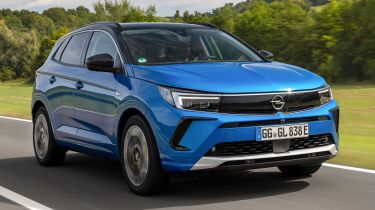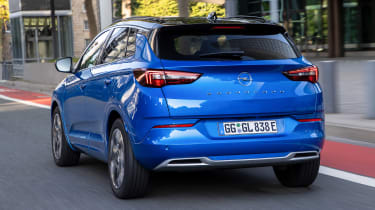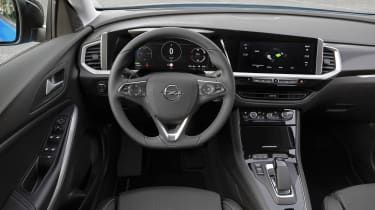Vauxhall Grandland Plug-in Hybrid Elite review
We find out if Vauxhall’s heavily tweaked Grandland PHEV SUV lives up to the hype

Verdict
The Vauxhall Grandland PHEV starts from £34,365, so it is at the more expensive end of the refreshed line-up, and an electric range of 34 miles means you’ll need to do a lot of recharging to recoup the initial outlay. A raft of visual updates have definitely freshened the Grandland and, steadily, Vauxhall’s range feels more cohesive as a result. But the Grandland is still a mid-table player at best, neither offending nor exciting potential buyers, albeit delivering strong efficiency, respectable comfort and practicality, and some strong upgraded tech.
Vauxhall is bringing its flagship SUV into line with the rest of its refreshed range of SUVs. The outgoing Grandland X didn’t exactly stand out against its more design-led Stellantis siblings, the Citroen C5 Aircross, DS 7 Crossback and Peugeot 3008, but it was at least decently practical.
Now, the Grandland has had a stylish makeover to compete with not only the rival brands within the Stellantis Group, but also the massive SUV sellers such as the recently launched Nissan Qashqai and the Skoda Karoq.
As a result, the Vauxhall (badged as an Opel in Europe, as our shots from our first taste of the new car show) loses the X from its name and gains a fresh face, including the Vauxhall Vizor front grille of the talented Mokka and newly revealed Astra. Having the appearance of a single, smooth piece, the new front-end design also introduces Vauxhall’s latest Adaptive IntelliLux LED Pixel headlight technology, comprising 168 LED elements to provide dynamic high beam lighting that doesn’t dazzle other road users. The family SUV market is moving at such a pace that you now need tech like this just to keep up.
Used - available now

2021 Land Rover
Range Rover
27,750 milesAutomaticDiesel3.0L
Cash £49,995
2022 BMW
3 Series Touring
52,456 milesAutomaticDiesel2.0L
Cash £23,800
2018 Mazda
6 Saloon
48,985 milesAutomaticPetrol2.0L
Cash £12,600
2023 Mercedes
EQC
55,207 milesAutomaticElectric
Cash £22,300New bumpers at each end, body-coloured wheelarch cladding and side skirts on SRi versions refresh the appearance, as does the contrasting gloss black roof.
The thorough mid-cycle facelift extends to the interior, with a new dual-screen layout called Pure Panel that modernises the cabin no end. A simple and clearly laid-out instrument display and infotainment system reduce the risk of distraction, in theory, while the Vauxhall retains physical controls for the cabin temperature (unlike some other Stellantis-owned brands), making the system easier and more intuitive to operate while you’re on the move.
Base SE versions get a pair of seven-inch displays, while a 12-inch driver display and 10-inch central touchscreen feature on SRi models and above. You’ll need to spend a little more to choose the pricey but well equipped Elite version we’re testing here.
This trim level features keyless entry, a powered tailgate, wireless phone charging, Vauxhall’s more supportive Ergo Active front seats and those new LED matrix headlights. So even though it’s the pricier of the two trim levels the PHEV powertrain comes in, it’s still more affordable than any plug-in Peugeot 3008, with which it shares its EMP2 platform. However, the Grandland doesn’t offer the French car’s flair or design interest when it comes to the interior, despite the much-improved cabin.
Rear passenger space is reasonably good in the Grandland, but boot capacity in this PHEV variant decreases to 390 litres, down from the usual 514 litres in its petrol-engined counterpart, due to the packaging of the battery pack underneath the floor. The volume can extend to 1,528 litres by folding the rear seats down.
Both the 1.2-litre petrol and 1.5-litre diesel engines remain in the line-up, and the former is the sweeter of the two. A single plug-in hybrid powertrain is available from SRi trim and above, with a combined maximum output of 222bhp. It is less powerful than the now-retired all-wheel-drive plug-in hybrid Grandland that produced 296bhp, but is cheaper to buy as well as being more efficient.
Vauxhall claims that the PHEV is capable of returning as much as 192mpg on the WLTP combined cycle, while emitting 31g/km of CO2, so company car tax payments should be relatively affordable. However, as with all plug-in hybrids, those figures are entirely reliant on frequent recharging of the 13.2kWh battery, which will take around two hours from a 7kW wallbox.
The Grandland can cover up to 34 miles on electric power, according to Vauxhall, after which it reverts to hybrid mode using the 1.6-litre four-cylinder petrol engine.
With a full battery, the Grandland is a competent and comfortable SUV. The electric motor delivers a level of power that is appropriate for typical urban driving. Up to 320Nm of torque can go to the front wheels from both power sources, so it’s brisk enough, but it doesn’t have the same instantaneous shove that can slingshot fully electric SUVs around. Still, the smoothness and near silence of how the Vauxhall drives around town are likely to be rather more relevant to potential buyers.
The claimed electric range of 34 miles does seem within reach as long as the speed is kept down. It is possible to drive at up to 83mph in EV mode, though doing so will put a dent into that battery range.
Once battery charge is depleted, the engine sparks to life and is quite smooth and refined at lower speeds. Ask for maximum performance, however, and the engine quickly sounds strained, while the usually-slick eight-speed automatic gearbox struggles to choose the right ratio.
You can run both motors simultaneously, but neither the chassis nor steering set-up is engaging enough to warrant attempts to extract the maximum performance.
This isn’t the sportiest of SUVs by any stretch. Instead, it combines efficient performance with good comfort, although it still lags behind the plusher-feeling Citroen C5 Aircross for supreme bump absorption.
It is, in many ways, a forgettable driving experience in that it performs its tasks without fuss, although for those in need of an SUV to lug around the family it is more than up to the task. The Grandland portrays itself as the capable and dependable SUV, and while the refreshed styling does make it a more appealing prospect, it still goes up against better-rounded competitors.
There is a saving grace though; buy online through Vauxhall’s store and at £33,765 for this Elite PHEV, you’ll receive a £1,250 discount. This extends to a deposit contribution on PCP finance, where a £4,831 deposit means the Grandland PHEV will cost £389 a month including optional metallic paint, based on a four-year contract with an 8,000-mile annual limit.
| Model: | Vauxhall Grandland Plug-in Hybrid Elite |
| Price: | £35,015 |
| Engine: | 1.6-litre 4cyl petrol & e-motor |
| Power/torque: | 222bhp/360Nm |
| Transmission: | Eight-speed automatic, front-wheel drive |
| 0-62mph: | 8.9 seconds |
| Top speed: | 139mph |
| Economy/CO2: | 192mpg/31g/km |
| EV range: | 34 miles |
| On sale: | Now |












